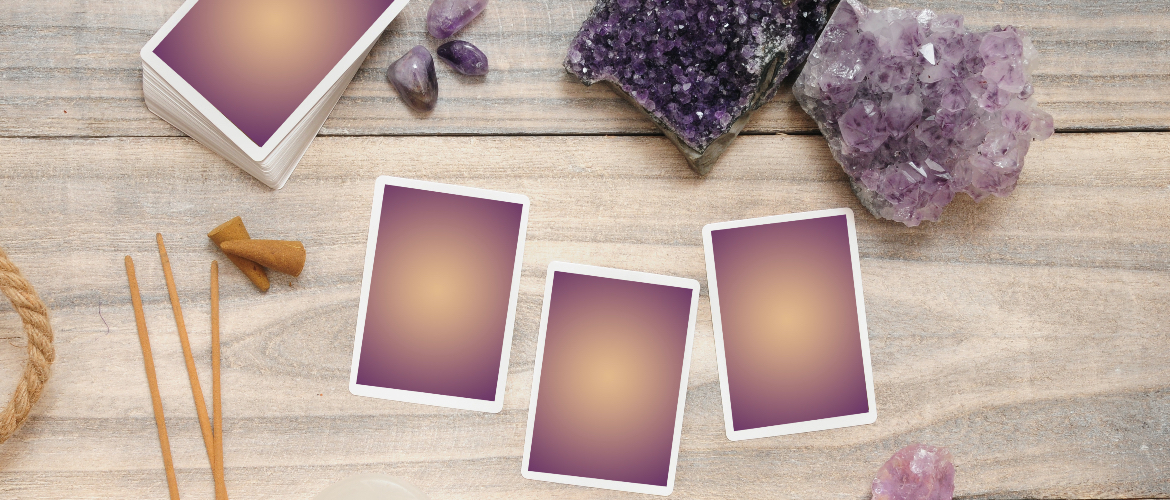Divination Tools; The Tarot
“As the poet plays with words, the musician with sounds and the painter with colors, so the tarotist plays with the interaction of tarot cards and the psyche.” ― Philippe St Genoux
Tarot is one of the most popular and widely known methods of divination. Tarot is no longer reserved for the mysterious gypsy-figure reading out of the back of a wagon or the corner storefront psychic with the flashing neon sign. It is common to get a reading from a friend, or at a work function or bachelorette party. Tarot is a tool for divination that can open up your psychic awareness.
History of Tarot
The history of tarot has many mysterious origins and influences from around the world. It is believed that the first tarot cards, called ‘Mamluk cards’ originated from Turkey, made their way to Western Europe. In Italy, wealthy families would commission an artist to create expensive custom decks, called “carte da trionfi” or “cards of triumph”. The suits used cups, swords, coins, and polo sticks (eventually changed to staves or wands), with courts consisting of a king and two male underlings.
Around the 14th century, the Italians used cards called ‘tarocchi’. It was inspired by the French word ‘Tarot’. Originally these cards were used to play a game similar to bridge and were not used for divination. By the 1500s, the Italian aristocracy was enjoying a game known as “tarocchi appropriati,”. Players would be dealt cards and use them to inspire poetry on the themes they predicted. Later Tarot became part of the occult philosophy. There the mystical origins go back to ancient Egypt.
In the mid-18th century, A French writer, Antoine Court de Gébelin believed that the tarot was based on an ancient Egyptian holy book and brought to Europe by Gypsies. Although this was not accurate, it inspired the teacher and publisher Jean Baptiste Alliette. In 1791, he wrote the book “Etteilla, ou L’art de lire dans les cartes,” meaning “Etteilla, or the Art of Reading Cards.” Etteilla claimed that the cards originated from the legendary Book of Thoth, belonging to the Egyptian god of wisdom. According to Etteilla, the book was engraved by Thoth’s priests into gold plates, providing the imagery for the first deck. It is believed that these engravings represented three levels of archetypes. DraEtteilla published his own deck in 1789 and is one of the first designed explicitly as a divination tool and eventually referred to as the Egyptian tarot.
Traditions of Tarot
The Tarot usually consists of a Major and Minor arcana for a complete deck of 78 cards. There are many traditions of tarot which offer unique and varied symbolism. Today’s Tarot decks are interpretations that often include unique cards and themes, with some deck creators focusing on inclusivity and representation that is more in alignment with modern-day living.
Rider- Waite/Rider-Waite Smith
The most popular of all decks is the Rider-Waite deck which has been continually printed since 1909. Named for publisher William Rider and popular mystic A.E. Waite, who commissioned Pamela Colman Smith (also called the Rider-Waite-Smith for that reason) to illustrate the deck, the Rider-Waite helped bring about the rise of 20th-century occult tarot used by mystical readers. Pamela Colman Smith (1878 –1951), also nicknamed Pixie, was a British artist, illustrator, writer, and occultist. She is best known for illustrating the Rider-Waite tarot deck of divinatory cards for Arthur Edward Waite. She died pennilessly and would never see the immense popularity and love for her artwork that is featured in the deck.
Thoth
In contrast, the meanings in other decks are particularly difficult to decipher, like the infamous Thoth Tarot developed by Aleister Crowley, notorious for his involvement with various cults and experimentation with recreational drugs and so-called “sex magick.” Completed in 1943, the Thoth deck was illustrated by Lady Frieda Harris and incorporated a range of occult and scientific symbols, inspiring many modern decks.
Lenormand
Mademoiselle Marie Anne Lenormand, who was popular around the turn of the 18th and 19th centuries, was the inspiration for the Lenormand decks. The decks bearing her name weren’t actually produced until after her death. The Decks contain fewer cards and rely more on the direct visual than the words associated with each card.
Tarot de Marsaille
The Tarot de Marseille deck was probably invented in northern Italy in the 15th century and introduced into southern France when the French conquered Milan and Piedmont in 1499. The 78-card version of the game died out in Italy but survived in France and Switzerland. When it was reintroduced into northern Italy, it incorporated the Marseilles designs. The earliest surviving cards of the Marseilles pattern were produced by Jean Noblet of Paris around 1650.
Commercial Appeal of the Tarot
Today, tarot production is a solid business for mass-market companies like Hay House, Lo Scarabo, US Games, as well as numerous Independents or ‘Indie’ deck creators. There is a major sub-culture of collectors who devote Youtube Channels, books and courses to discussing the finer details of decks, deck art, creation, and interpretation. Deck collectors seek out vintage and custom decks with the passion and intensity of art collectors. The widespread appeal and mass-market popularity of tarot make the use of cards a welcomed tool in a professional psychic reading space.
Methods of Divination using Tarot Decks
The traditional method of reading follows the symbols and themes of each deck creator. Each deck has a tradition of standard meanings for each symbol. One of the most popular methods for card reading is starting with the Little White Book or “LWB” to look up simple descriptions for each card. The LWB and standalone books are based on the author’s interpretations. Intuitive reading enlists the reader’s power of intuition and psychic abilities to read information from the images on each card. This method can provide a highly personalized and unique reading.
Uses for Tarot
The tarot can be used to predict by considering a question or overall situation. The minor arcana may be used to indicate the lengths of time and seasons. Tarot may also be used to look at life themes that influence an individual. Tarot may be used as a tool for personal development, journaling, and creative writing.
Tarot Spreads
A tarot spread refers to the arrangement of the cards for a reading. Each card may have a different ‘position’ in the reading. Most traditional spreads include the one-card, three-card and Celtic Cross spread. Modern spreads focus on a variety of themes related to relationships, health, career, Year of the Wheel, and question and answer. The possibilities are limitless. Due to the archetypal nature of the major arcana (sometimes viewed as the Hero’s Journey or exploration of Archetypes) tarot is a wonderful tool for writing. Tarot can be addictive and a great daily practice, however, it is also possible to rely too heavily on this practice to understand and make decisions. Ultimately you have your own knowing and no divination tool or particular reader is the key to your own answers.
Psychic Perspective
Tarot can be a fun and easy pathway to enter into the development of intuition and psychic awareness. It is a diverse tool that may be also used for personal insights and growth, as well as storytelling and writing. When using the tarot, the intuitive approach to reading is an ideal method to compliment a psychic reading. This involves using psychic tools for meditation to get into trance and ‘reading’ the card using clairvoyance or claircognizance. Tarot is only a tool or a conduit to accessing information that ultimately comes from your own intuitive and psychic abilities. From a professional reading point of view, tarot offers an image for the readee to focus their energy on, allowing more mental ‘space’ for the reader to work. For someone who is new to the world of psychic development, tarot is a comfortable starting point.
If you want to explore psychic tools, meditation, and psychic development, sign up for our Clairvoyant Meditation Free Open House to learn about course offerings or book a psychic reading or spiritual healing through The Psychic School.


